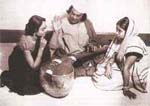Indian High Commission publishes “Nazrul Bichitra”
 Late 1960s. On Kazi Narul Islam’s birthday, at his Kolkata residence, the poet’s family, friends and well-wishers had gathered for an informal celebration. A lei-laden poet is at the centre of the soiree. One after another, artistes are paying homage to the ‘Rebel Poet’ who had by then turned silent. Manabendra Mukhopadhyay started singing “Bagicha-e Bulbuli Tui” . A big smile brightened up the visibly excited Nazrul’s face. To the surprise of hundreds of artistes and journalists, the poet took
Late 1960s. On Kazi Narul Islam’s birthday, at his Kolkata residence, the poet’s family, friends and well-wishers had gathered for an informal celebration. A lei-laden poet is at the centre of the soiree. One after another, artistes are paying homage to the ‘Rebel Poet’ who had by then turned silent. Manabendra Mukhopadhyay started singing “Bagicha-e Bulbuli Tui” . A big smile brightened up the visibly excited Nazrul’s face. To the surprise of hundreds of artistes and journalists, the poet took
off a garland and put it on Manabendra’s harmonium. Almost moved to tears by this gesture, the singer said, “I have just received the greatest honour.”
Khilkhil Kazi, Nazrul’s granddaughter, remembers this vividly. This [first published in Bharat Bichitra, May 2009] and many other memorable incidents from Nazrul’s
life, as well as scholarly evaluations of the poet’s literature and songs, are included in Nazrul Bichitra. The compilation of write-ups by noted columnists,
litterateurs and Nazrul’s family members, has been published by the High Commission of India in Bangladesh on the occasion of the 90th anniversary of publication of
Nazrul’s most famed creation, Bidrohi.
About the book, Sanjay Bhattacharyya, Deputy High Commissioner of India, wrote in the preface, “His [Nazrul’s] Bidrohi, published in 1922, became a national phenomenon
overnight. Governments of Bangladesh and India have decided to jointly celebrate the 90th anniversary of the historic event in Dhaka and Delhi. This book is the Indian
High Commission’s tribute to the poet. Most of the write-ups had appeared in Bharat Bichitra, the monthly magazine published by the high commission. The poet’s family
and the Nazrul Institute in Dhaka have helped us in bringing out this book.”
The book starts off with the full version of Bidrohi and segues into Achintyakumar Sengupta’s Jaishthher Jhor. Sengupta compares Nazrul to the Bengali month,
Jaishthha. The second, scorching month of Bengali summer doesn’t bring languor inducing comfort, but shakes up the stagnancy. This is also a time when the best of
fruits ripen under the unforgiving sun and turn sweet as honey. Nazrul was born in this month and his demeanour, as well as his music and poetry, share these traits.
Amritalal Bala explores the close relationship between Nazrul and his “Gurudeb”, Rabindranath Tagore. Diehard fans often try to pit the two greatest Bengali poets
against each other, but this ludicrousness becomes obvious when one studies the relationship between the two. By the time Nazrul made his breakthrough Tagore was
already a world-renowned poet. Nazrul looked up to Tagore as a mentor. Tagore, reciprocally, showered the young poet with heartfelt admiration. This bond is evident in
numerous letters between the two creative titans and their conversations. If Tagore is an infinite ocean, Nazrul is the tempest surrounding it. They cannot be compared
to each other, but only be treated as complementary.
Kazi Sabyasachi (Nazrul’s son), Kalyani Kazi (Nazrul’s daughter-in-law) and Khilkhil Kazi (Nazrul’s granddaughter) provide insights into the personal life of the poet;
before and after he lost his voice and memory to a mysterious illness. The reader learns about a doting father, a loving husband, and a larger than life talent whose
creativity was incarcerated by a cruel disease too soon.
Among other write-ups on Nazrul included in the compilation are: Nazrul-Shahityer Punorbichar: Dhara O Prokriti by Alauddin Al Azad; Sangeet-Bhuboney Nazrul by Kazi
Mozammel Hossain; Nazrulke Jantam by Premendra Mitra and Bidrohi Kobi: Bidrohi Kobita by Syed Shamsul Haq.
The biggest attraction, however, is an accompanying CD that contains renditions of Nazrul Sangeet –
Pashaner Bhangaley Ghum, Ghumaitey Dao Sranto Robirey — and his poems –
Shamyer Gaan Gai and Robihara — by the poet himself.
Courtesy of The Daily Star




















